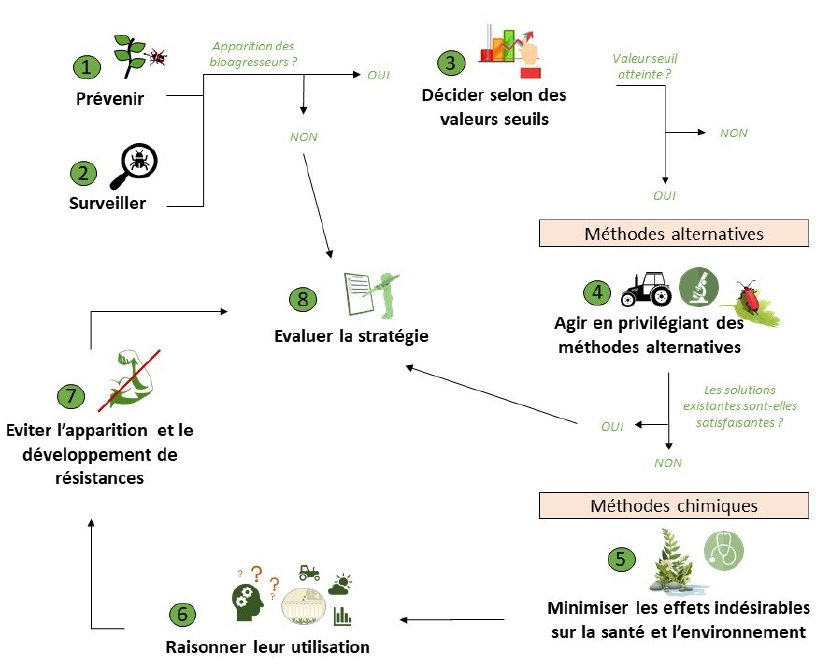Integrated Crop Protection (ICP)
 Biocontrol, beneficials, false seeding, rotation, seeding density, ...
Biocontrol, beneficials, false seeding, rotation, seeding density, ...

The aim of Integrated Crop Protection (ICP) is :
- Reduce the use of pesticides
- Minimise environmental impact
- Reduce the cost of control
This type of control is based on 8 main principles[1].
Principles of integrated crop protection

Preventing the appearance of pests and diseases
Integrated crop protection is based on the use of prophylactic methods to ensure that plants are in the best possible condition to resist all pests and diseases. The aim here is to prevent a pest from becoming dominant or harmful in the crop system.
Various methods can be used :
- Increasing crop rotation
- Use of adapted cultivation techniques (sowing dates and densities, adapted pruning, direct sowing, etc.)
- Use of resistant varieties
- Balanced use of fertilisation, liming and irrigation
- Implementation of hygiene measures in the presence of diseases or pests, particularly in the case of greenhouse crops
- Protecting and strengthening natural enemies
Monitoring the appearance of harmful organisms
Integrated crop protection is secondly based on increased monitoring of plots and recognition of organisms, whether harmful or beneficial.
Use threshold values as a decision rule
Integrated crop protection takes into account threshold values to determine whether or not to apply phytopharmaceutical measures.
Favour the use of non-chemical control methods
Integrated crop protection gives priority to biological and physical control methods :
- Biological control
- Biocontrol
- Physical control
Choose selective pesticides and minimise undesirable effects on health and the environment
When prevention and alternative control methods are not satisfactory, chemical methods may be used. As part of integrated crop protection, pesticides must be as specific as possible and have minimal side-effects on human health, non-target organisms and the environment.
Using pesticides rationally to reduce their use
Integrated crop protection is also based on reducing the use of plant protection products :
- Reducing the frequency of treatment
- Reduction in quantities applied per unit area cultivated :
- Positioning of treatments
- Adaptation of doses
- Optimisation of treatments :
- Choice of pesticide application periods and conditions
- Adjusting equipment and spraying techniques
Implementing a strategy to avoid the emergence of resistance
It is important to manage the risk of resistance in order to maintain the effectiveness of products over time. There are various strategies for doing this :
- Use of pesticides with different modes of action
- Adaptation of the strategy on a case-by-case basis depending on the molecules used
Monitor and evaluate the strategies put in place in order to assess " the success ".
It is important to evaluate the strategies implemented as part of integrated crop protection, taking into account :
- Pest pressure
- Preventive control methods used
- Curative control methods used
- Incidents or unforeseen events
This evaluation enables the techniques used to be constantly adapted to observations in the field. It is also necessary to monitor technological developments and take an interest in new preventive measures (new varieties, equipment, etc.) and curative methods (biocontrol products, chemical active substances, etc.) to improve crop protection.